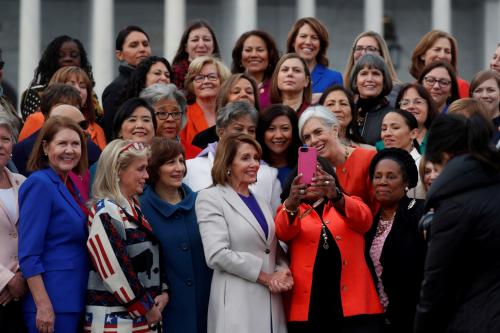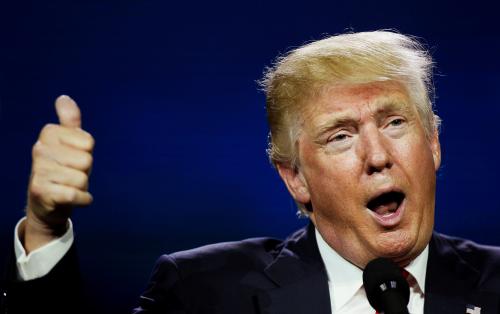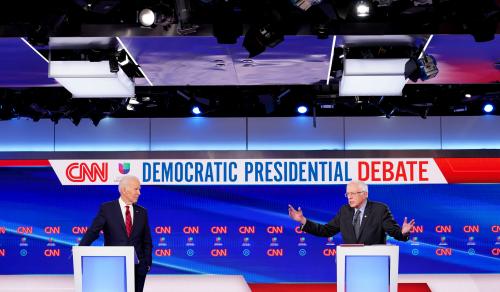 In the 2018 elections, women played a bigger role than they have in any other election in American history. Two hundred and fifty-five women ran for office in the two major parties. And as of Wednesday morning, Democratic women had won nearly half (47 percent) of their races for 93 seats, and Republican women had won 24 percent of their races for 13 seats.
In the 2018 elections, women played a bigger role than they have in any other election in American history. Two hundred and fifty-five women ran for office in the two major parties. And as of Wednesday morning, Democratic women had won nearly half (47 percent) of their races for 93 seats, and Republican women had won 24 percent of their races for 13 seats.
Previous groundbreaking years for women were 1984, when Geraldine Ferraro ran as the first ever female vice presidential nominee on Walter Mondale’s ticket and, of course, 2016, when Hillary Clinton became the first woman presidential nominee of a national party. But 2018 shares the most in common with 1992, when eleven women ran as major party candidates for the Senate and five were elected and 106 women ran for the House, with 23 percent winning.
The gains of women in both of these years were fueled, at least in part, by anger as a result of high-profile accusations of sexual misconduct against a Supreme Court nominee—Clarence Thomas in 1991 and Brett Kavanaugh in 2018.
The women joining Congress in 2019 will cover the spectrum when it comes to ideology and background. In Brooklyn, New York voters elected a young woman named Alexandria Ocasio-Cortez, a self-described Democratic socialist who won in a very liberal district that has been solidly Democratic for decades. In Congress, she will join Mikie Sherrill, a former Navy helicopter pilot and ex-federal prosecutor who won in a New Jersey district that had been held by Republicans for more than 30 years. In New Mexico, voters sent the first Native American woman to Congress when they elected Debra Haaland, who was endorsed by Bernie Sanders’ group, Our Revolution. In Pennsylvania, Democrats elected Chrissy Houlahan, an Air Force Veteran and entrepreneur who won in a narrowly Democratic district.
Thus, whether or not the new women in Congress, especially Democrats, will have an appreciable effect on the ideology of their caucus remains to be seen. But we know from past studies of women in legislatures that the increased presence of women is likely to have two effects. According to former Ambassador Swanee Hunt, an internationally known advocate of women in leadership roles here and abroad, “… as a group, men and women take strikingly different approaches to crafting legislative agendas … Women are more likely to introduce bills of importance to families … The difference women make in politics isn’t limited to the Democratic Party.”
Second, women in legislative roles have been more likely to reach across the aisle. According to one study by political scientists, under some conditions, “while men may choose to obstruct and delay, women continue to strive to build coalitions and bring about new policies.”
As for women voters, the gender gap in American politics remains strong. According to the Center for American Women and Politics, “The gender gap in presidential voting first appears in 1980 in the election of Ronald Reagan and it has remained a steady feature of presidential elections ever since then—with women voting for Democrats.”
In addition to their preference for Democrats, women have voted in higher numbers than men since 1984 and 10 million more women are registered to vote than men. But women’s preferences for Democrats does not mean that Democrats win. They only win when the women’s preferences for Democrats exceed men’s preferences for Republicans—which was not the case in 2016.
The gender gap in 2018 was alive and well. According to exit polls, women constituted 52 percent of the electorate, compared to 48 percent for men and 59 percent of women voted for Democrats while 51 percent of men voted for Republicans. This was evident in the wave of suburban congressional districts that flipped from Republican to Democratic, giving Democrats control of the House. Among white voters, there was an 11-point gender gap. Exit polls showed that 49 percent of white women voted for Democrats and that 60 percent of white men voted for Republicans.
The presence of so many women in government at the national level will have important effects on policy but it may also have longer-term effects. Advocates for more women in politics hope that even the women who lost will stay in the game and run again, thus continuing to grow the number of women in office. And Republicans would be wise to try and temper the excessive testosterone and latent racism that sometimes erupts in their campaigns—given that there appear to be more women voters than men.
Note: This post was updated to correct the exit polling statistics for white men and women.
The Brookings Institution is committed to quality, independence, and impact.
We are supported by a diverse array of funders. In line with our values and policies, each Brookings publication represents the sole views of its author(s).








Commentary
2018: Another ‘Year of the Woman’
November 7, 2018